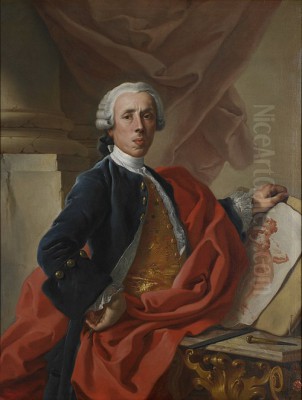
Francesco de Mura stands as a pivotal figure in the vibrant art scene of eighteenth-century Naples. An Italian painter of immense talent and prolific output, his life spanned from 1696 to 1782, a period of significant stylistic transition in European art. De Mura masterfully navigated the shift from the exuberant dynamism of the Late Baroque and the elegant grace of the Rococo towards the clarity and order of Neoclassicism. Primarily active in Naples, with a significant period spent in Turin, he became one of the most sought-after artists of his time, leaving an indelible mark on the churches and palaces of Southern Italy and beyond. His legacy is defined by his luminous frescoes, sensitive altarpieces, and insightful portraits, all characterized by technical brilliance and evolving aesthetic sensibilities.
Early Life and Training in Solimena's Shadow
Born in Naples in 1696, Francesco de Mura entered the world at a time when the city was a major European cultural capital, renowned for its distinctive school of painting. His artistic journey began in earnest around 1708 when he entered the bustling studio of Francesco Solimena (1657-1747). Solimena, known as "L'Abate Ciccio," was the undisputed leader of the Neapolitan school, inheriting the mantle from predecessors like Luca Giordano. Solimena's studio was the most important training ground in Naples, and his influence on the young De Mura was profound and lasting.
Under Solimena's tutelage, De Mura absorbed the tenets of the late Baroque style: dramatic compositions, rich color palettes, and a masterful handling of light and shadow (chiaroscuro). Solimena's own work blended the theatricality of the Baroque with a certain academic rigor. De Mura quickly proved to be one of Solimena's most gifted pupils. Some sources also suggest he spent time learning from Domenico Viola, another Neapolitan painter, though Solimena's impact remained paramount. De Mura's early works, such as the Saint Benedict Welcomes Totila (circa 1710), already demonstrate a remarkable technical facility, though still closely aligned with his master's style.
The Enduring Influence of Francesco Solimena
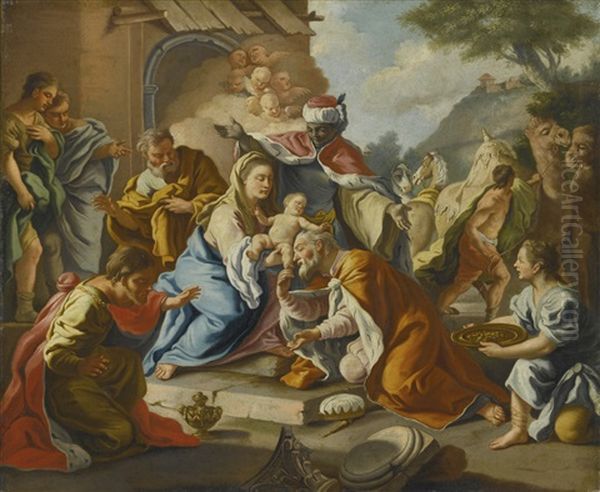
The relationship between Francesco de Mura and Francesco Solimena was more than just that of student and teacher; it was a complex dynamic of emulation and eventual divergence. For much of his early career, De Mura was seen, sometimes critically, as a faithful follower, even an imitator, of Solimena. He adopted his master's compositional structures, figural types, and dramatic intensity. This close association undoubtedly helped De Mura gain access to important patrons and commissions early in his career.
However, even while working within Solimena's stylistic orbit, De Mura began to cultivate his own artistic personality. His brushwork often displayed a greater softness and refinement compared to Solimena's more robust energy. His color palette, while still rich, gradually moved towards lighter, more luminous tones, hinting at the emerging Rococo sensibility. While Solimena's influence provided a powerful foundation, De Mura's inherent elegance and sensitivity allowed him to adapt and evolve this inheritance into something distinctly his own. This evolution became more pronounced as his career progressed.
Rising to Prominence in Naples
By the 1720s and 1730s, Francesco de Mura had established himself as an independent master and a leading figure in the Neapolitan art world. His talent earned him numerous prestigious commissions from the Church, the aristocracy, and the Bourbon monarchy that ruled Naples. His Rest on the Flight into Egypt (1725-1727) showcases his growing confidence and stylistic refinement during this period. He became highly sought after for large-scale decorative cycles, particularly frescoes, which adorned the ceilings and walls of Naples' most important religious and secular buildings.
Among his significant Neapolitan projects were extensive fresco decorations in churches such as San Severino e Sossio. Tragically, these particular frescoes, considered masterpieces of his mature Baroque phase, were destroyed during Allied bombing raids in World War II (1944). He also contributed works to the church of Santa Maria Donnaregina Nuova, including depictions of Virtues and an Adoration of the Magi. His paintings can still be found in the Pio Monte della Misericordia complex in Naples, including another version of the Adoration of the Magi and the sensitive Portrait of the Artist's Wife. These commissions cemented his reputation as a versatile artist capable of handling grand narratives and intimate portrayals with equal skill.
The Turin Interlude and Rococo Refinements
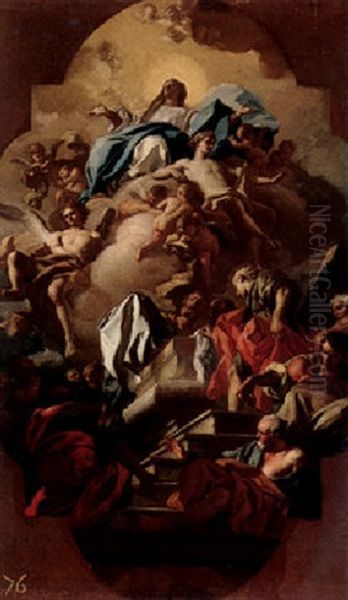
A significant chapter in De Mura's career unfolded between 1741 and 1743 when he was summoned to Turin to work for the House of Savoy at the Royal Palace (Palazzo Reale). This period exposed him directly to the prevailing artistic currents of Northern Italy and, importantly, to the international Rococo style, which was favored by the Savoy court. This experience had a noticeable impact on his art, infusing it with a new lightness, elegance, and decorative grace.
During his stay in Turin, De Mura executed important commissions, including allegorical ceiling paintings for Maria Amalia of Saxony, Queen of Sardinia (and later Queen of Spain through her marriage to Charles III). These works demonstrate a shift towards brighter, cooler color palettes, more fluid compositions, and a delicate, almost ethereal quality. The Turin interlude allowed De Mura to absorb Rococo aesthetics, which he skillfully integrated into his existing Neapolitan Baroque foundation. This synthesis distinguished his work from contemporaries like Corrado Giaquinto, who more fully embraced the Rococo, and Sebastiano Conca in Rome, who adhered more strictly to a classicizing academic tradition.
Mature Style: Bridging Baroque and Neoclassicism
Returning to Naples, De Mura entered the most mature phase of his career, his style now a sophisticated blend of his Neapolitan training, Rococo elegance acquired in Turin, and an emerging Neoclassical sensibility. While he never fully abandoned the dynamism and emotional depth of the Baroque inherited from Solimena, his later works increasingly displayed characteristics associated with Neoclassicism: greater clarity of line, more ordered compositions, simplified forms, and a calmer, more restrained emotional tone.
His palette remained luminous, often employing pastel shades alongside richer tones, and his handling of light became even more refined, creating gentle transitions and highlighting forms with a soft radiance. Works like the magnificent ceiling fresco The Assumption of the Virgin in the church of the Annunziata in Arienzo exemplify this mature style. It combines the upward-sweeping movement typical of Baroque ceilings with Rococo grace in the figures and a Neoclassical sense of order in the overall structure. He achieved a unique balance, retaining decorative appeal while moving towards greater formal simplicity and serenity, prefiguring the dominant style of the later eighteenth century.
Major Works and Enduring Themes
Francesco de Mura's oeuvre is vast, encompassing large-scale frescoes, numerous altarpieces for churches throughout Southern Italy, allegorical paintings for palaces, devotional works for private patrons, and portraits. Religious themes dominated his output, reflecting the deep piety of Neapolitan society and the demands of his primary patrons. He depicted scenes from the Old and New Testaments, the lives of saints, and allegories of virtues with remarkable skill and sensitivity.
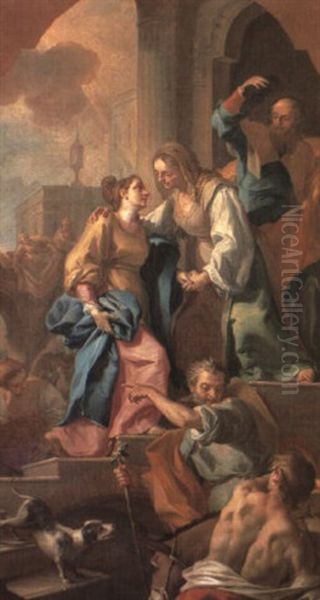
Key representative works, besides those already mentioned, include:
Frescoes for the Royal Palace of Naples (collaborating with others).
Works for numerous Neapolitan churches, including San Domenico Maggiore, Santa Chiara (though specific attributions require care), and the Gerolamini.
The Allegory of Divine Wisdom (Palazzo Reale, Turin).
The Visitation (various versions).
Christ and the Samaritan Woman.
Allegory of Painting.
Saint Joseph with the Child - Paternal Love (Museo Alto Garda, Riva del Garda).
His frescoes for the Abbey of Monte Cassino, another major commission, shared the tragic fate of those in San Severino e Sossio, being destroyed in World War II. Despite these losses, a significant body of work survives, showcasing his mastery of composition, color, and emotional expression across various scales and subjects. His ability to convey both divine grandeur and human tenderness remained a constant throughout his career.
Workshop and Pupils
As a leading master in Naples for several decades, Francesco de Mura maintained an active workshop and trained a number of pupils, ensuring the continuation of the Neapolitan painting tradition, albeit infused with his own stylistic innovations. While the influence of his teacher, Solimena, remained potent in Naples even after Solimena's death, De Mura's own elegant and increasingly classicizing style also shaped the next generation.
Among his documented pupils, Pietro Bardellino (c. 1731-1806) and Giacomo Diano (active late 18th century) are perhaps the best known. Bardellino, in particular, carried forward De Mura's lighter palette and graceful compositions, becoming a notable painter in his own right. Other names sometimes associated with his studio, such as Felele Fichetti or Orsozio Torni, are less certain or documented. Through his teaching and the widespread dissemination of his own works, De Mura played a crucial role in guiding Neapolitan painting through the stylistic transitions of the mid-to-late eighteenth century, moving away from the high drama of the Baroque towards a more refined and ordered aesthetic.
Contemporaries and the Artistic Context of 18th-Century Italy
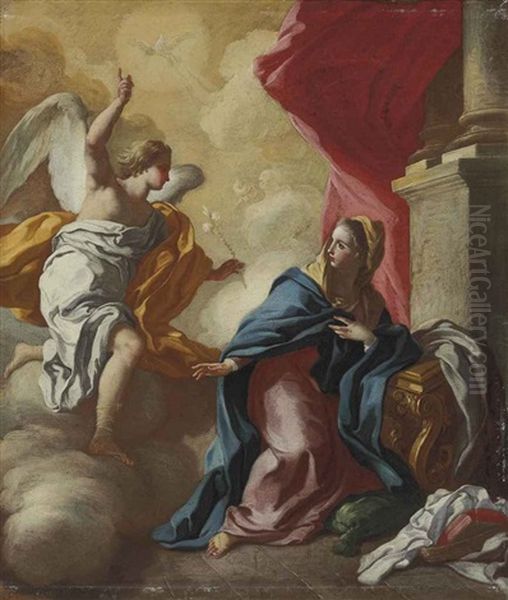
Francesco de Mura operated within a rich and complex artistic landscape. His primary point of reference remained his teacher, Francesco Solimena, whose dominance in Naples shaped the environment De Mura initially navigated. He also collaborated on projects, such as the decoration of the Royal Palace in Naples around 1738, alongside artists like Nicola Maria Rossi and the versatile architect-sculptor-painter Domenico Antonio Vaccaro.
His style is often compared and contrasted with other major Italian painters of the era. In Naples itself, Corrado Giaquinto (1703-1766) represented a more fully Rococo direction before leaving for Rome and Spain. Sebastiano Conca (1680-1764), though Neapolitan by birth, was primarily active in Rome and represented a more academic, classicizing trend. De Mura's unique position lies in his synthesis of Neapolitan Baroque traditions with Rococo elegance and Neoclassical clarity.
Looking beyond Naples, the eighteenth century saw flourishing schools across Italy. In Venice, Giovanni Battista Tiepolo (1696-1770), De Mura's exact contemporary, brought ceiling painting to unparalleled heights of airy Rococo brilliance, while view painters like Canaletto (1697-1768) captured the city's luminous atmosphere. While De Mura's style remained rooted in the Neapolitan tradition, his awareness of broader Italian and European trends, particularly Rococo and emerging Neoclassicism, is evident in his artistic evolution. He stands alongside figures like Pompeo Batoni in Rome as an important artist navigating the transition towards Neoclassicism. Earlier Neapolitan masters like Luca Giordano and Mattia Preti (a contemporary of Solimena, not De Mura's student) had laid the groundwork for the city's Baroque prominence.
Later Years and Lasting Legacy
Francesco de Mura remained active until late in his life, dying in Naples in 1782 at the venerable age of 86. He witnessed the full arc of the Rococo period and the firm establishment of Neoclassicism as the dominant European style. His long career and prolific output ensured his enduring influence on Neapolitan art. While some early critics may have focused on his perceived dependence on Solimena, subsequent art historical evaluation has recognized his distinct contribution and his crucial role as a transitional figure.
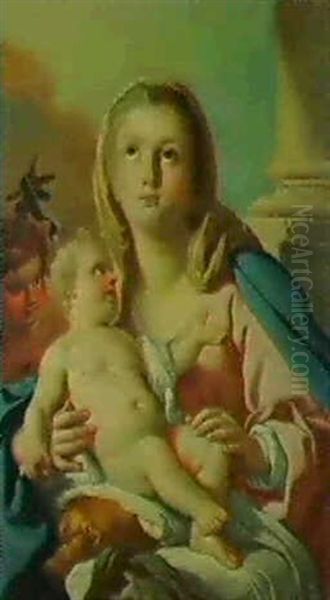
His art represents a culmination of the Neapolitan Baroque tradition, refined and lightened by Rococo grace, and streamlined by the clarity and order of Neoclassicism. He successfully adapted his style to changing tastes while maintaining a high level of technical excellence and emotional resonance. The destruction of major works during World War II was a significant loss, but numerous paintings and frescoes survive in churches, palaces, and museums across Italy and internationally, including institutions like the Louvre in Paris. These works stand as testament to his skill and his importance in eighteenth-century Italian art.
Conclusion: A Bridge Between Eras
Francesco de Mura was more than just a follower of Solimena; he was a master in his own right who forged a unique and influential style. His art forms a bridge between the dramatic intensity of the Late Baroque and the ordered elegance of Neoclassicism, incorporating the decorative charm of the Rococo along the way. As the leading painter in Naples for much of the mid-eighteenth century, he fulfilled major commissions for church and state, leaving a rich legacy of frescoes and canvases characterized by luminous color, graceful composition, and refined execution. His ability to synthesize diverse stylistic influences while maintaining a distinct artistic identity marks him as a key figure in the history of Neapolitan and Italian art, a painter whose works continue to captivate with their beauty and technical brilliance.